|
The land of unity in Diversity…India has a
strategic position in Asia with Arabia and Africa on the
west across the seas, and Burma, Malaysia and the
Indonesian Archipelago on to the east. Geographically, the
Himalayan ranges keep India apart from the rest of Asia,
and as a result India has developed into a land of unique
culture. Bounded on the southwest by the Arabian Sea and
on the southeast by the Bay of Bengal, the grand old
Himalayan ranges lie on the north, north east and
northwest. Kanyakumari constitutes the southern tip of the
Indian peninsula and seems tapering down into
the Indian Ocean. India shares its political border with
Pakistan and Afghanistan on the west and Bangladesh and
Burma on the east. The northern boundary comprises the Sinkiang province of China, Tibet, Nepal and Bhutan. India
is separated from Sri Lanka by a narrow channel of sea
formed by the Palk Strait and the Gulf of Mannar
India is a republic consisting of 28 states and seven
union territories with a parliamentary system of
democracy. It has the world's twelfth largest economy at
market exchange rates and the fourth largest in
purchasing power. Economic reforms since 1991 have
transformed it into one of the fastest growing
economies. India's history and culture is ancient and
dynamic, spanning back to the beginning of human
civilization.
India's history is more than just a set of unique
developments in a definable process; it is, in many
ways, a microcosm of human history itself, a diversity
of cultures all impinging on a great people and being
reforged into new, syncretic forms. IndHistory.com
brings you the india's history starting from ancient
history of india to modern indian history.
CULTURE & HISTORY
The roots of Indian civilization go deep to hoary, pre-recorded history. The recorded history sheds light on the sub-continent during Early, Middle and Late Stone Ages (400,000-200,000 BC). Crude weapons supposed to be in use in these periods had been excavated from Rajasthan, Gujarat, Bihar and Punjab province of Pakistan.
The Paleolithic people were semi-nomadic hunters for many millennia. Agricultural, rather settled life style evolved in the middle of the 9the millennium B C. Five main races then prevalent were Negrito, Proto-Australoid, Mediterranean, Mongloids and Alpin.
During the same period plains of Egypt, Mesopotamia and Persia also witnesses those developments similar to have reported in India. Settlements on Indus gradually grew and the inhabitants started using weapons made of copper and bronze.
Another milestone in the history of civilized human life was domestication of animals. They also made pottery and began trade activities through barter system.
|
The Indus Valley Civilisation |
Settlements
|
From the beginning of the 4th millennium BC, the individuality of the early village cultures began to be replaced by a more homogenous style of existence. By the middle of the 3rd millennium, a uniform culture had developed at settlements spread across nearly 500,000 square miles, including parts of Punjab, Uttar Pradesh, Gujarat, Baluchistan, Sind and the Makran coast.This earliest known civilization in India, dates back to around 3000 BC. Stumbled upon in 1920s, it was thought to have been confined to the valley of Indus, hence the name Indus Valley civilization. This civilization was sophisticated, urban and two of its towns, Mohenjodaro and Harappa, |
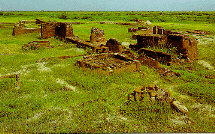 |
|
represent the high
watermark of the settlements. Subsequent archaeological excavations established that the contours of this civilization were not restricted to the Indus valley alone but spread to North-West and Western India. Later, Indus valley civilization was known Harappan civilization. Mohenjodaro and Harappa are now in Pakistan and the principal sites in India include Ropar in Punjab, Lothal in Gujarat and Kalibangan in Rajasthan. |
Urban Development
The emergence of Mohenjodaro and Harappa civilization was remarkable for its stability for nearly a thousand years. Cities were well planned and buildings were built with baked bricks having same size; the streets were laid at right angles with drainage system. There was a fairly clear division of localities and houses were stratified based on their occupants social status. There were also public buildings, the most
famous being the Great Bath at Mohenjodaro. Remnants of furnaces unearthed vindicate the claim that metals such as copper, bronze, lead and tin were in use in those days. The discovery of brick-making kilns indicate that burnt bricks were used extensively in domestic and public buildings.
Occupations
|
Evidence also points to the use of domesticated animals, including camels, goats, water buffaloes and fowls. The Harappans cultivated wheat, barley, peas and sesamum and were probably the first to grow and make clothes from cotton. Trade during that period was advanced. Discoveries suggest that the Harappan civilization had extensive trade relations with neighbouring regions in India and states in the Persian Gulf and Sumer (Iraq). Seals discovered from the site suggest that each merchant or mercantile family owned its own seal. They had quadrangular shapes, each with a human or an animal figure carved on it. |
 |
|
Society and Religion |
|
|
During the period, the sole criterion for pigeonholing people was their occupation which in turn suggests the existence of an organized society. The figures of deities on merchants' seals indicate that the Harappans worshipped gods and goddesses and had developed some rituals and ceremonies. No monumental sculpture of the period survives today, except a couple of human figurines, including a steatite bust of a man supposed to be of priest, a bronze dancing girl and terra-cotta statues of Mother Goddess.By around 1700 BC, the Harappan culture was on the wane. Flooding of river bank towns and subsequent ecological changes which forced inhabitants to seek greeny pastures led to the early grave of the civilization. A section of historians do not rule out forays of barbarian tribes from the North-West as the cause of the decline of the much-praised Harappan civilization. When Aryans began their Indian incursion in 1500 BC, the Harappan culture had already been wiped out.
|
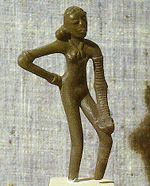 |
|
 |
|
The Aryans and The Vedic Age
Aryans are said to have entered India through the fabled Khyber pass, around 1500 BC. They interacted with the locals, got themselves entangled into the social fabric, followed the settled agricultural lifestyle of their predecessors and established small agrarian communities across the then Punjab region.The Aryans are believed to have brought horse to Indian soil, developed the Sanskrit and made significant inroads into religious practices of the time. Horse, Sanskrit and Religion were the weapons Aryans used to conquer Indian land, language and mind respectively. Cavalry warfare facilitated the spread of Aryan kingdom across North India.Sanskrit is the basis and the unifying factor of thevast majority of Indian languages. The religion, that took root during the Vedic era, with its myriad Gods and Goddesses, and its repository of myths and legends, became the foundation of the Hindu religion, arguably the common denominator of Indian culture.he Aryans did not have own script, but developed a rich literary tradition. They composed the hymns of the four vedas, the great philosophic poems that were the core of Hindu thought. As the Nobel Laureate, Rabindranath Tagore expressed, "The hymns are a poetic testimony of a people's collective reaction to the wonder and awe of existence....A people of vigorous and unsophisticated imagination awakened at the very dawn of civilization to a sense of inexhaustible mystery that is implicit in life."A settled lifestyle in turn led to complex forms of government and social pattern. This period saw the evolution of the caste system, and the emergence of kingdoms and republics. The events described in the two great Indian epics, the Ramayana and the Mahabharata, are thought to have occurred around the period from 1000 to 800 BC.The Aryans were divided into tribes which had settled in different regions of northwestern India. Tribal chieftainship gradually became hereditary, though the chief usually operated with the help of either a committee or the entire tribe. With work specialization, the intra- division of the Aryan society developed along caste lines. Their societal framework was divided into: the Brahmana (priests), Kshatriya (warriors),Vaishya (agriculturists) and Shudra (workers). It was, in the beginning, a division of occupations; open and flexible. Later, birth(caste status) became the deciding factor and change from one caste or occupation to another became difficult
|
|
Rise of Religions and Emergence of the State
|
Buddhism and Jainism
The sixth century BC was a time of social and intellectual upheaval in India. It was then that Mahavira founded Jainism, and Gautam Buddha Buddhism. The two great religions, preached non-violence, tolerance, self-discipline and moral values which, in the later period, become the cornerstones of the Indian ethos. The simple, practical and enlightening teachings of Mahavira and Buddha gained wide acceptance among general public. Their teachings were in vernacular tongue which made the penetration of the two religions facile.
Later, Buddhist monks were to spread their religion south to Sri Lanka and north-east to China, Japan, Korea and the whole of South-east Asia.
|
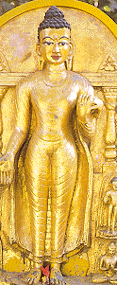 |
|
|
Rise of the State
With land becoming property and the society being divided on the basis of occupations and castes, conflicts and disorders were bound to arise. Power centre emerged to resolve outstanding issues cropped up in the social life. That gradually led to the formation of full-fledged state governing bodies, including vast empires.
|
|
The Mauryan Empire
By the end of the third century BC, Chandragupta Maurya wrested many North Indian states and established the first great Indian empire. His son Bindusara extended the Mauryan empire over virtually the entire subcontinent. The greatest Mauryan emperor was Ashoka the Great (286-231 BC) whose successful wars culminated in the capture of Kalinga (modern Orissa). Moved by the ravages of war, Ashoka, the victorious king, renounced blood- shedding battlefield. A transformed Ashoka embraced Buddhism, but did not insist his men follow suit. Instead, he ventured on spreading non-violence by inscribing edicts on wayside rocks in the local dialects, using Brahmi, the post-Harappan script.
The Mauryan economy was essentially agrarian. The State owned huge farms and works were done byslaves. Taxes collected on land, trade and manufacture of handicrafts were the other major sources of income during this era.In 327 BC, Alexander of Macedonia ( Alexander the Great) crossed into North-West India. He conquered a major chunk of Indian territory before his generals, exhausted of war, forced him to return home. Alexander entrusted his governors to boss over Indian territories won by him. However, conflict among governors saw these regions going back to the hands Indian rulers. The "Alexander effect" was felt on Indian art and culture. Sculptures of the region bear a marked Greek influence.
Ashoka's death in 232 BC, led to the disintegration of the Mauryan empire. This was an open invitation for invaders from Central Asia to try their fortunes in India. This period saw the up and down of several tiny kingdoms. |
|
The Gupta Age
The Gupta empire of the Fourth century AD was one of the dynasties that survived for over two centuries, and since the kings were obsesses with usurping the weak states in the neighborhood, the kingdom spread over the entire sub continent and empire's boundaries kept fluctuating. Notwithstanding, the administration was more or less decentralized.
Hindu religious tradition had the blessings of Gupta dynasty, hence the orthodox Hinduism was assertive during this period. The period also witnessed the coexistence of Brahmins and Buddhists. Fa Hien was among the prominent travelers who visited the sub continent. Ajanta and Ellora caves were completed. Classical art forms had their golden era during the Gupta period.
|
Erudite treatises on subjects ranging from grammar to Kamasutra were written. Literature and science, particularly astronomy and mathematics, were revived. One of the outstanding literary figures of the Gupta period was Kalidasa whose choice of words and imagery brought Sanskrit to new heights. Aryabhatta, who lived during this age, was the first Indian to make significant contribution to astronomy.
The invasions of the White Huns signaled the end of Gupta era, although initially Guptas weathered the alien storm. After the decline of the empire, north India was sliced into many separate Hindu kingdoms and continues so until the advent of Muslims. |
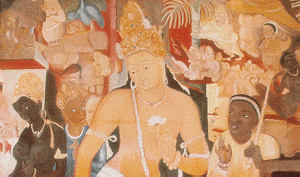 |
The Southern Kingdoms
The political upheavals in the northern part of the subcontinent did not create even ripples in the Southern region. Hinduism continued to flourish in the south while Jainism and Buddhism gradually became popular in the centre and north of India. The prosperity of the south-west coast was mainly due to the trade links of local kingdoms with other western kingdoms. The Egyptians and Romans had trade links with southern India and later, with South-East Asia.
|
Arrival of St. Thomas, Apostle of Christ, in 52 AD was an
epoch-making event. His missionary
activities in south-east coast heralded
the conversion of Hindus to
Christianity. Dynasties such as
Cholas, Pandyas, Cheras, Chalukyas and
Pallavas were always on war for
supremacy of the southern region. The
Deccan region of central India was under
the sway of Chalukyas. At times, their
hands were drawn to the North. In South,
the Pallavas pioneered. In 850 AD, the
Cholas rose to power and gradually
superseded the Pallavas. Under the rule
of Raja Raja Chola, the Chola empire
spread all over southern India, the
Deccan, Sri Lanka, parts of the Malay
peninsula and Sumatra. They also
took Indian art forms and Hinduism to
Java in Indonesia, Thailand and
Cambodia.The temple conglomerates in Thanjavur stand testimony to the architectural
dexterity of Cholas.In Kerala, the
Cheras hosted Arab traders who had
discovered a fast sea route to
India depending the monsoon winds. Some
of them settled here permanently, and
were allowed to freely practice their
religion. |
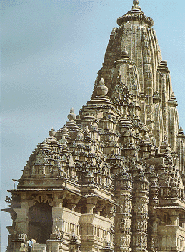 |
|
|
 |
|
AD1000 Hindiusm on deathbed, Islam emerging
Muhammad of Ghazni Ghazni, one of the greatest military leaders the world has ever seen, attacked India.His invasion was the greatest shock India received in the past 2000 years. The dreaded military leader made17 forays into India and plundered the fabulously rich temple of Somnath in Kathiawar in the first year of the millennium. By 1001 he had burned Mathura temple and ransacked Kananj. Few in India could resist the Ghazni juggernaut. Greed and Steel drove him into victories. His invasion synchronized with the extinction of the Hindu Shahiya Kingdom of Punjab.
However, temple building-spree reached its zenith, the significant among them being Khajuraho (Madhya Pradesh) built by Chandelas and the Lingary temple in Orissa with erotica emerging as a finely-honed art form.
Even as Islam was rising on India horizon like a green sun, Sanskrit received a boost with the resurgence of Brahmanical Hinduism in South India. Another milestone was the introduction of paper by Muslim invaders.
The South India witnessed the arrival of Christianity from West Asia and so do Jews.
|
|
1100AD Extinction of Hindu rule
The century was marked by the extinction of Hindu rule in the North. Muhammed Ghori defeated Prithviraj Chauhan and Delhi came under Turkish control, thus completed the foundation laying ceremony of Muslim dominance in North. Qutibuddhin Aibek, Ghore's trusted lieutenant extended Turkish Empire by capturing Meerut, and Ranthambhor in 1192.He defeated the Benares Raja and Kanauj in 1194, plundered Gujarat in 1197 and captured Badaun, one of the richest cities of Hindustan of that period. The marauding Turks continued their onslaught on Indian culture when Nalanda University was burned to cinders and 10,000 monks were slaughtered. Towards the fag end of the century the Buddhist influence was also on the ebb. Bhaskaracharya II, the last of the great Indian mathematicians, invented many algebraic symbols, crudely anticipated differential calculus. His appearance in the 12th century would seem a little quaint in the historical puzzle, for that was a period of Hindu scientific siesta. Though ancient Indian mathematicians had discovered zero, it was Bhaskara, who realized and interpreted its general implications. Another major event was the completion of Ellora cave temples.
|
|
1200 AD Delhi Sultanate established, Qutub Minar constructed
Qutubudhin Albek assumed power in Delhi and established the slave dynasty. After Ghor’s death in 1206, he became the first Sultan of Delhi.The three sultans Qutubudhin, IItumish, Balban were slaves but later emancipated by their masters. In 1210 IItumish, completed the 250ft high red sandstone minaret, Qutub Minar. In 1221, the Mongolians led by dreaded marauder, Chengizkhan, reached the banks of the river
Indus.Iltutmish's daughter Razia succeeded him (1236), the only woman to occupy the throne of
Delhi. Her feat in Indian history remained intact until Indira Gandhi assumed power in the second half of 20th century.
In an era of bloodshed and intrigue, Razia was deposed and killed. Weak successors follow till Ghoysudhin Bulban assumed control in 1266. Muizuddin Kaiquabad succeeded him in 1287.
Indian kitchen also witnessed a "foreign attack". Onion was introduced. Chewing of paan is raised to sophistication. The century also witnessed the advent of tea, silk, porcelain and gunpowder. In 1288, Marco Polo the intrepid traveler journeyed through India.
|
|
1300 AD Sufi, Bhakti movements dominate
Jalaludhin Khilji, an Afghan origin, was the first Muslim ruler to put forward the view that since majority are Hindus, the Indian state cannot be truly Islamic. However the impact of the Muslim rulers was fathomless. Language, dress, cuisine, art architecture and social custom were vulnerable to the Islamic influence. Allauddhin Khilji brings Mawa and Rajasthan under his control; general Malik Kafur led the troop to South India. The best known of Allauddhin's conquest is the seizure of Chittor in Andra Pradesh.Lesser Khilji followed in quick succession till Tughlaks brought Khilji dynasty to a close. The paper cone, still in use in the 20th century serve snacks, harks back to this period. From the confluence of Islam and Hinduism emerged Sufi thought and the Bhakthi movement, which dominated the
India psyche for two centuries. The Hindu elite adopted purdha. Arabic became the official script. A mixture of Hindi and Persian slowly evolved into Urdu.Calligraphy was honed to become the highest aesthetic Islamic art.
The Tughlak Dynasty (1320-1412)
Under Ghiyasuddin, the Sultanate reached Madurai. In 1325 Muhammad Bin Tughlak issued token currency of brass and copper. With his vision of geocentric seat of power, Muhammad Bin shifts the capital from Delhi to Daulatabad and back again.In 1336 the Vigaya Nagar kingdom founded. The capital of Hastinavti (Hampi) grew to be the richest city
India is yet to know. In 1398 after the death of Firuz Shah Tughlak, Timur the Lame invaded India and the short-lived Sayyid dynasty established.Hasare Gangu founded Bahaman kingdom (1346-1689), Firuz Shah Bahmani was the most remarkable figure in the dynasty. The Gol Gumbazx in Bijapur, one of the largest domes in the world, and the Charminar in Hydrabad are built during this period. |
|
1400 AD Religious revival, Sikh Community comes into being
Krishna Deva Raya founds the Tuluva dynasty of Vigaya Nagar. Literature, music and art flourished. Hinduism was back with a vengeanc e. Mammoth temples were built.The diamond mines of Golgonda flourished .In 1510 Portuguese captured Goa.
Mughal dynasty:The last Lodi sultan, Ibrahim's misdemeanors led Babar into India with the first battle of Panipat in 1536. The illustrious Mughal ruler established a Central Asian dynasty. In 1530, Babar's son Humayun secured the former’s legacy.In 1539, Sher Shah Suri, the Afghan ruler of Bengal and Bihar, supplanted Humayun, who had to spent 12 years in exile. Sher Shah established rupee as the basic coin and build the Sonargaon-East Peshawar Grand Trunk Road.n the second battle of Panpat, Akbar succeeded Humayun. The most enlightened ruler in the medieval period, Akbar, abolished pilgrimage taxes. A patron of arts, music and literature, he introduced polo, a Persian game, and was a connoisseur of food. During his period Indo-Islamic culture attained a peak of tolerance, harmony and a spirit of enquiry. |
|
  
Babur Akbar Jehangir |
|
The nobles of his court belonged to a cross section of communities and Akbar put forth himself as a tolerant man by marrying a Hindu. His court at Fatehpur Sikri was a meeting place for religious heads of the day.Pinapples, guavas ad custard apples made their way to India from America via Europe. |
|
1600 AD The British East India Company established
Queen Elizabeth I established the British East India Company on December 31, 1600. In 1605 Jahangir, succeeded Akbar. In the next year, Sikh Guru Arjan was executed. The East India Company extended their operations and established the first factory at Mazulipatanam. In 1615 Sir Thomas Roe arrived in India. After Britain, the Dutch established trading post in Surat. In 1639 Madras (now Chennai) was leased out to Eat India Company that built the imposing St. George Fort.In 1690 Job Charnock laid foundation stone for modern
Calcutta. IN 1690, The English obtain Zamindari of Sutanuti, Kolikata and Govindapur.
Shah Jahan1628-1658:Shah Jahan ascended the throne. Replacing Akbar’s liberal, tolerant views, with rigid rules, Shah Jahan gave a boost to orthodox Islam. Steps were adopted to take back Islam into its ‘purity’.The Mughal architecture was at its peak during his regime. Shah Jahan built Taj Mahal in memory of his favorite wife Mumtaz Mahal. Persian artisan Isa, Halian Gieronimo Veronco and French man Austin De Bordeau were the designers of the $230,00 building. Later Lord William Bentict considered the palatial marble mansion selling for $ 150,000 to a French contractor because the marble could be put to better use.In 1646, redoubtable Marathas under the leadership of Shivaji emerged a threat to the British. Marathas, the non-Brahmin castes in the Maharashtra region had been legendary fighters. Shivaji assumed the title Chathrapatrhi in 1676.In 1674, Francois Martin established a French settlement in Pondicherry.
|
|
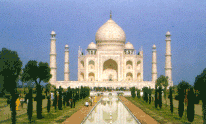 
Taj Mahal Shahjahan |
Aurangazeb (1658-1707) jailed Shah Jahan and assumed power. Under Aurangazeb, Mughal Empire reached its territorial zenith with the empire extending from Kashmir to Jinji and from the Hindukush to Chittagong. He banned entertainments and liquor. The technique of ice making was refined and Kulti appears as India's first ice cream.
In 1698 Guru Gobind founds Khal
|
|
1700 AD Decline of Mughal Empire, Sun rises on the Raj
A century after the British reached India, the native kings and Islamic invaders began to feel the heat of the European attack. Britain made strategic moves to entrench themselves in the country. A fortified British settlement named Fort William came up in Calcutta. In 1707 Aurangzeb died. Later, Farukh Siyar became the Mughal emperor. Slowly the role of the East India Company extended to many realms, with the company having been allowed privileges including the minting of the company coins in Bombay and recognizing it as accepted currency through out the Mughal dominions, the company permitted free trade in Bengal. In 1739, Nadir Shah invaded Delhi, leaving the Mughal Empire bleeding and prostrate. In 1757, on June 25, Robert Clive defeated Sirajud Daullah and Afghan raider Ahmed Shah Abdali was thrown out of Delhi.
Maratha march was abruptly halted in 1761 at Panipat, when Afghan ruler Ahmed Shah Durrani defeated fighting brigade from Maharashtra. The inevitable was lurking. The imperial power was there to overwhelm the successors of Chatrapathi Shivaji. In South, Hyder Ali and his son Tipu of Mysore posed threat to English interests in the Deccan (1761). The Anglo –Mysore wars (1767-1792) ended up with the historical Sreerangapattanam treaty. After the battle of Buxart in 1764-65, Bihar and Orissa went into the British hands.In 1774, Warren Hastings became the Governor General. Supreme court was established in
Calcutta. After a series of Anglo-Maratha wars between 1775-1819, Baji Rao II the then Maratha ruler surrendered to Sir John Malcolm on Jan 3 1818. With this the Maratha dominance declined and British entrenched in the Maratha belt. The British contributions began to trickle in the later half of the 18th century. James Augustus Hickey brought out the country’s first newspaper Hickey's Bengal Gazette on Jan 29, 1781. Another major event of the century was founding of Serampore mission by William Carey in 1799. The newspapers brought out by Serampore missionaries had created ruffled the feathers of Raja Ram Mohan Roy. He later brought out a few newspapers to counter the missionaries’ media.
 |
|
1800AD British empire consolidates |
|
|
The century witnessed a few pitched battles between Indian kings and British troops, at the end of which the later emerged winners. A major chunk of the subcontinent was brought under the feet of the East India Company. This was synched with the spread of western education more so English. Thomas Babington even went to the extent of denouncing classical Indian learning in favour of English education. In 1828 Lord William Bentick took the charge of Governor General. Raja Ram Mohan Roy starts the Brahama Samaj, heralding a new era in social reformation and enlightenment. He launched Samachar darpan, a Bengali daily, first vernacular in India.
Raja Ram Mohan Roy’s fight against superstitions and social evils reaped results when the British government prohibited Sati in 1829. (Sati was prevalent among Hindus, a custom that forced a widow jump into the flames of her husband’s pyre. The orthodox Hindus could not stomach the prohibition. Later they too caved into the public pressure.) Sri Ramkrishna Parama Hamsar, founder of Arya Samaj, was born in 1836. He established several ashrams in various parts of the country. A few medical colleges also came up in the first half of 19th century. Universities of Calcutta, Madras, Bombay, Lahore and Allehabad were established between 1857-1888. In 1848, Lord Dalhousie became the Governor General. The sub continent first heard the clickety-clang of train when a train steams off from Bombay to Thane on 35 km track in 1853.The event of the century was in 1857: Sepoy Mutiny, which is celebrated as the first war of Independence. It witnessed the volcanic eruption of the pent-up of a generation. In the spontaneous struggle princely states, peasants and aristocrats rallied behind Bahadur Shah Zafar, the last Mughal emperor who was later exiled. The aftermath of the mutiny, among others, was a sense of unity among the Indians. IN 1858 the British East India Company was divested of it’s governing power and as per an Act passed in British Parliament, Queen Victoria took over as Empress of India. Another milestone in the development of the country was the setting up of the telegraph line between Calcutta and Agra in 1883 |
|
The freedom struggle got a further boost when Indian national Congress was founded in 1885.Even as Indian fight against foreign ruler was at its zenith, an Indian had been creating waves in America. Swami Vivekanandhan, a towering Hindu leader, made thought provoking, rousing speech at World Parliament of Religion in Chicago (1893)Lord Curzon becomes Governor General in 1899. Calamities also struck India. Plague storms Bombay in 1897, Famine wreaks havoc in Bihar in 1874.The last lap of the century had darned its due to the fashion world. Thanodanadini Devi, wife of Satyandranath Tagore, devised the modern sari and stitched blouse and petticoat as a clever amalgamation of Persian and Maharashtran styles.
|
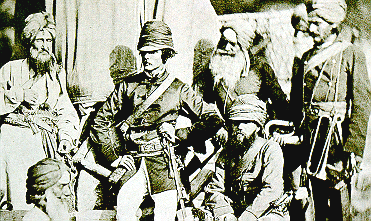 |
|
1900AD A Century of transition
A sense of unity was penetrating Indian psyche with leaders from all walks of life coming out supporting the freedom struggle. Balagangadhar Tiluk, a firebrand leader of the days, demanded Swaraj (self rule), he had even the audacity to declare, “Swaraj is my birthright”.
Partition of Bengal in 1905 was a watershed in the history of the sub continent.
Next year saw the rise of a green sun on the Indian political firmament. Muslim League was formed as a rallying point for Muslim population in the country.
British transplanted the empire capital from Calcutta to Delhi in 1912. Rabindhranath Tagore, Bengali literati, won Nobel Prize bringing cheer to Indians. He also received Knighthood from Britain, but renounced it after the Jallainwalla Bhagh massacre in 1919.
The second decade of the century saw the emergence of Mohandas Karamchand Gandhi, as the leader of freedom struggle. Gandhi, a native of Probandhur in Gujarat and British-trained lawyer, had a short stint as a leader when he organized Indians in South Africa against apartheid.
He was back in India with a novel weapon, “Ahimsa”, to fight the imperial forces. He led a Spartan life and was eclectic of religion.
He led the non co-operation movement of the 1920 and soon donned the mantle of Congress leadership. A none- peril leader in the history, Gandhi unleashed a slew of fighting strategies. The civil disobedience movement of the 1930 and famous Dhandhi march were a few. Civil disobedience and Gandhi’s Dandy march. In 1935, more than six million women received the right to vote.
In 1942, Subhash Chandra Bose formed Indian National Army.
1947 Independence. The sub continent was partitioned to India and Pakistan. Muhammad Ali Jinna became the leader of Pakistan. Jawaharlal Nehru was sworn in as Prime Minister of India. The partition was followed by communal flare-up involving Hindus and Muslims.
The triumph of the Indian Freedom movement was one of the most significant historical processes of the century. It changed the political face of the world and chimed the death knell of British imperialism.
Lord Mount Baton was appointed the first Viceroy of Independent India. On 31, 1948, Gandhiji was shot dead by Nathuram Godse, a Hindu fundamentalist.
India became Republic in 1950.The fifties was a decade of planning for a fledgling India. Planning Commission was formed in 1951 and the first five-year plan was launched in the same year.
French settlements such as Chandernagore and Pondicherry became union territories and states were reorganized based on language (1956).
The sixties saw India waging battle with its neighbours China and Pakistan. The 1962 Indo-China conflict ended with the both countries agreeing to panchaseel, five principles of agreement.The war with Pakistan, the ever-truculent neighbour of the country, had a lasting impact. The sores of the 1965 war are still afresh, forcing the both to engage in continual fight.
After the death of Nehru, his daughter Indira Gandhi assumed power (1965). Her main achievement in the early days of governance was nationalization of banking sector, which made the banking accessible for the poor and downtrodden. India made public its nuclear prowess in 1974 at Pohkran in Rajasthan.
Mother Theresa, an Albanian missionary and founder of Missionaries of Charity in Calcutta brought Nobel Prize to India in 1979.The Operation Blue star’, military operation in Golden temple of Sikhs in Amrthsir in Punjab was a blot on the Indian political history (1984). Those were the days of terrorism in Punjab and the operation was to flush out militants suspected to be camping in the temple.
Extremist Sikhs were reportedly harbouring grudge against Indira Gandhi, the then Prime Minister. The same year she was shot dead by her own trusted bodyguards belonging to the Sikh community. After her assassination, son Rajiv Gandhi succeeded. Rajiv, Pilot-turned Prime Minister, met with his tragic end in an explosion at Sreeperumbathoor near Chennai. Tamil extremists who had a score to settle with Rajiv who sent Indian troop to the war-torn Sri Lanka designed the explosion.
In the election that followed the catastrophic event, Congress romped home. Narasimha Rao, a low-profile politician became prime minister. His Finance Minister Man Mohan Singh kicked off the economic reforms.
In 1992, Babari Masjid, a controversial structure at Ayodhya in UP, was demolished by Hindu extremists groups.
In 1993 A massive earthquake killed as many as 30,000 at Lathur in Maharashtra.
BJP, the so-called political untouchable in the country, came to power for 13 days in 1996.
United Front, motley of more than a dozen parties took over. Later the Front shattered and in a snap poll, BJP was back in Delhi with a coalition .
In 1998 the BJP Government successfully experimented the nuclear explosion at Pokhran.
Amerthya Sen, economist won Nobel Prize for economics (1998). The Indian army had a tough task of flushing out the Pak-sponsored infiltrators from Kargil heights on India-Pak border. The four- month- long “Operation Vijay”, claimed as many as 500 brave-Indian lives.
In the election that followed the Kargil operation in 1999, BJP was back in power.

|
|